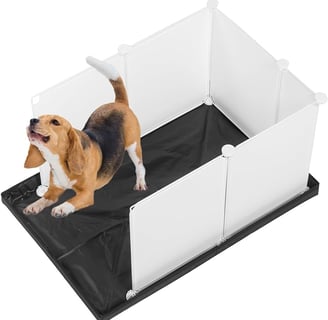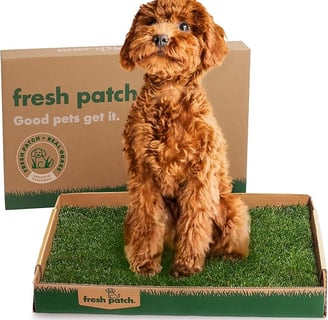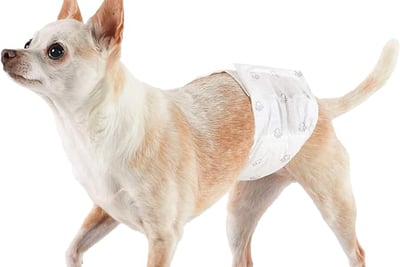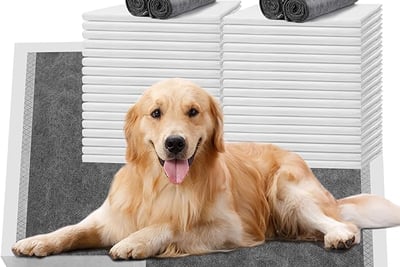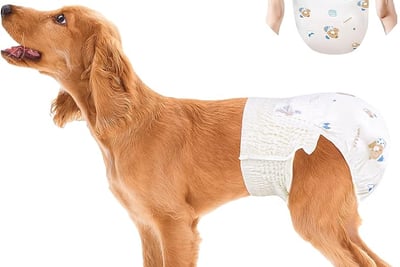Understanding Dog Bathroom Options: Limited Outdoor Access
8 min read


Introduction to Dog Bathroom Options
Establishing appropriate bathroom options for dogs is an essential consideration for pet owners, particularly those residing in apartments or homes with limited outdoor access. With urban living increasingly becoming the norm, many dog owners face unique challenges related to potty training and bathroom management for their pets. It is crucial to create a designated bathroom area to promote good hygiene, well-being, and convenience for both dogs and their owners.
In environments where outdoor access is minimal, there tends to be an increased likelihood of accidents indoors. Consequently, pet parents must find innovative solutions that cater to their dogs’ needs while maintaining a clean living space. Some versatile alternatives include indoor potty systems, artificial turf areas, and dog litter boxes. Each option presents its own set of benefits and potential drawbacks, depending on the space available and the dog’s size, breed, and individual preferences.
Moreover, the potty training process requires patience and consistency, which can be more challenging in urban settings. The absence of readily accessible outdoor areas can contribute to confusion for dogs, as they may not understand where or when they are expected to relieve themselves. Utilizing appropriate bathroom alternatives is vital in facilitating a smooth potty training experience and ensuring that pets are comfortable and accustomed to their designated areas.
Understanding the various options available for dog bathroom management will empower pet owners to make informed decisions. Whether utilizing indoor potty solutions, creating a private outdoor space, or opting for dog-friendly landscaping, having a well-planned bathroom setup can greatly enhance the quality of life for both furry companions and their humans. In light of these considerations, it becomes evident that reevaluating bathroom options is not just an ancillary concern; rather, it is a fundamental aspect of dog ownership, particularly in urban living scenarios.
Common Bathroom Solutions for Apartment Living
For pet owners residing in apartments or homes with limited outdoor access, finding effective bathroom solutions for dogs can be challenging. However, several products cater specifically to these unique living situations, enabling pets to relieve themselves indoors without causing unnecessary inconvenience to their owners.
One popular option is the use of pee pads. These absorbent pads provide a designated area for dogs to urinate indoors. Pee pads come in various sizes and levels of absorbency, making it easier for owners to choose the right one based on their dog’s size and needs. One of the primary advantages of using pee pads is their convenience; they can be placed in a specific area of the home and are easy to dispose of. However, some dogs may develop a preference for using these pads over going outside, potentially leading to behavioral issues.
Another option gaining traction among apartment dwellers is the indoor dog potty system. These systems often consist of a base, a collection tray, and a surface that mimics grass, allowing dogs to simulate the experience of relieving themselves outdoors. Indoor potty systems can be particularly beneficial for those who may not have the time or ability to take their dogs out frequently. Despite their advantages, these systems require regular cleaning to maintain hygiene and may not suit all dogs, especially those with strong preferences for outdoor environments.
Lastly, artificial grass patches have emerged as a practical solution for apartment living. These patches resemble real grass and provide a more natural surface for dogs to relieve themselves. They are easily cleaned and generally odor-resistant, catering to pet owners who prioritize aesthetics and convenience. Nevertheless, these installations can be more expensive than other options, and proper maintenance is required to ensure cleanliness and function.
In conclusion, exploring various indoor bathroom options can significantly enhance the quality of life for both pets and their owners in apartment settings. Each solution has its pros and cons, necessitating careful consideration to find the best fit for both the lifestyle of the owner and the preferences of the dog.
Setting Dogs Up for Potty Training Success
Potty training dogs in environments with limited outdoor access requires a strategic approach to ensure success and ease for both pets and their owners. Establishing a consistent routine is paramount; this means taking your dog out at the same times each day, including after meals, naps, and play sessions. A predictable schedule aids in signaling to your dog when it is time to relieve themselves, ultimately creating a habit. This consistency helps dogs understand that there are designated times and spaces for bathroom needs, which is crucial in settings such as apartments.
Positive reinforcement is another essential strategy for successful potty training. When your dog successfully relieves itself outside or on an indoor potty solution, reward them immediately with praise, treats, or playtime. This method reinforces the desired behavior and encourages your dog to repeat it. It is important to remain patient and persistent, as different dogs may require different amounts of time to adapt to their specific surroundings. Gradually, your dog will begin to associate the act of relieving themselves in the appropriate place with positive outcomes.
Additionally, recognizing signs that indicate your dog needs to go out is critical. Common behaviors include sniffing around, circling, whining, or heading towards an entrance. Observing these signals critical in environments with limited access to outdoor spaces. Responding promptly when you notice any of these cues helps prevent accidents and teaches your dog to communicate their needs effectively. Keeping an eye on your dog after meals or during playtime can also provide valuable insights into their bathroom habits.
In conclusion, utilizing a consistent routine, positive reinforcement, and understanding your dog’s signals can significantly enhance the potty training process in areas with restricted outdoor access. These strategies not only promote successful training outcomes but also foster a more harmonious living environment for both pets and their owners.
Handling Incontinent Dogs with Care
Incontinence in dogs can be a particularly challenging issue for pet owners, especially in situations where outdoor access is limited. This condition may stem from various factors, including age-related changes, urinary tract infections, hormonal imbalances, or anatomical defects. It is critical for pet owners to understand the underlying causes of incontinence and how to manage it effectively to maintain a comfortable living environment for both the pet and the owner.
One of the primary strategies for managing a dog with incontinence is to establish a regular bathroom schedule, ensuring that the pet has ample opportunities to relieve itself. By keeping a consistent routine, pet owners can help minimize accidents indoors. Additionally, providing a designated indoor potty area can be a practical solution. Products such as puppy pads, artificial grass, or indoor dog toilets can help in managing bathroom needs without compromising hygiene. Ensuring this area is easily accessible and encouraging the dog to use it regularly can ease the owner's burden of constant clean-up.
For dogs that experience involuntary urination, reinforced training and positive reinforcement are essential. Using command words or cues may help in training the dog to associate specific actions with bathroom breaks. It is also beneficial to consult with a veterinarian for a tailored approach, as they can pinpoint the underlying cause of incontinence and may recommend treatments such as medications or supplements to aid in bladder control.
Moreover, it is essential to keep the living space clean. Utilizing waterproof bedding, washable covers, and enzymatic cleaners designed to eliminate pet odors can significantly enhance cleanliness and comfort. In summary, addressing canine incontinence requires a multifaceted approach, including establishing routines, utilizing appropriate products, and seeking veterinary guidance to ensure pets can live comfortably, regardless of limited outdoor space.
Choosing the Right Bathroom Option for Your Dog's Size and Age
Selecting the appropriate bathroom option for your dog involves careful consideration of several key factors, particularly their size, age, and health. Each dog is unique, and their bathroom solution should cater to their specific needs to ensure comfort and accessibility. Large breeds, for instance, may require more spacious bathroom areas that accommodate their size, while smaller breeds can utilize compact spaces. Additionally, the age of your dog significantly impacts their bathroom needs; puppies might need more frequent access, while senior dogs may struggle with mobility and require an easily accessible solution.
For growing puppies, consider options that provide ample space and easy access to facilitate their bathroom training. A designated potty area with a soft surface can mitigate discomfort and encourage proper habits. As dogs mature into adulthood, they may benefit from bathroom options that offer privacy, as well as surface materials that are easy to clean and maintain. Using absorbent pads or grass-like substrates designed for indoor use can be advantageous for both young and adult dogs.
Furthermore, health considerations must also be taken into account when choosing a bathroom solution. Dogs with mobility issues, such as arthritis, may require ramps or raised surfaces to ease their access to designated potty areas. For senior dogs, a consistent routine can help alleviate anxiety around bathroom breaks, allowing them to feel secure in their environment. Therefore, customizing the bathroom solution to meet the individual requirements of your dog, whether through specific products or adapting your living space, will enhance their overall comfort and wellbeing.
Creating a Designated Potty Area Indoors
Establishing a designated potty area indoors is essential for dog owners, particularly those living in apartments or homes with limited outdoor access. This designated space not only aids in housebreaking but also provides a predictable environment for the dog to relieve itself. Choosing the right location for this area is key; it should be a quiet, low-traffic spot that is easily accessible to your pet. Ideally, this area should be away from their food and water bowls to maintain cleanliness and encourage usage.
When setting up the indoor potty area, consider using materials that are easy to clean and maintain. Many pet owners opt for options such as disposable pads or artificial grass specifically designed for indoor potty needs. These options can absorb moisture and control odors effectively, making it more appealing for dogs to use. If using artificial grass, select a model that is washable for easy maintenance. Additionally, you may want to include a low-sided tray to help contain messes and facilitate cleaning.
Regular cleaning is crucial to maintaining hygiene in the designated potty area. This includes promptly disposing of waste, cleaning the surface regularly with pet-safe cleaners, and fully disinfecting the area at least once a week. A clean environment not only keeps your apartment smelling fresh but also encourages your dog to use the space consistently. Moreover, maintaining this area can be enhanced by using positive reinforcement when your dog uses it correctly, such as offering treats or praise. This method reinforces good behavior and helps establish a routine for your pet.
Ultimately, creating a designated potty area indoors is a practical solution for dog owners in urban settings. By carefully selecting the location, using suitable materials, and maintaining cleanliness, it is possible to effectively manage your dog's bathroom needs indoors, ensuring both comfort for your pet and a pleasant living environment for you.
Conclusion and Final Tips for Dog Bathroom Success
In navigating the complexities of providing adequate bathroom options for dogs in apartments or homes with limited outdoor access, it is imperative to consider various solutions that fit your specific environment and your dog's needs. Throughout this blog post, we have explored various strategies, from indoor potty systems to the implementation of designated bathroom areas that accommodate pet requirements while also considering the convenience of their owners.
One of the key takeaways is the importance of consistency in establishing a bathroom routine for your dog. As with any aspect of pet care, the foundation of successful potty training relies on clear expectations and patience. Utilizing options such as artificial grass pads, litter boxes specifically designed for dogs, or potty patches can greatly simplify this process, offering your pet a reliable place to relieve themselves indoors. Additionally, regular outdoors sessions for exercise and fresh air can greatly contribute to your dog’s well-being and facilitate their understanding of their bathroom cues.
Another point worth reiterating is the significance of positive reinforcement. Encouragement and rewards can foster a favorable association with using their designated bathroom area. It is advisable to remain patient and understanding, as each dog may adapt to these solutions at their own pace. Furthermore, assessing your pet's behavior and preferences can lead to finding the most effective and comfortable bathroom option for them, ensuring their needs are adequately met.
As you embark on identifying and implementing these solutions, remember that each living situation presents its own challenges. Remaining adaptable and proactive in your approach will contribute greatly to achieving success in managing your dog's bathroom needs. Be prepared to experiment and adjust as necessary and celebrate the small victories along the way. Ultimately, establishing a stable routine will benefit not only your dog's comfort but also enhance your experience as a responsible pet owner.

